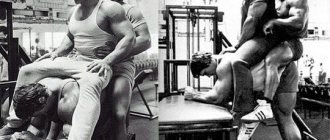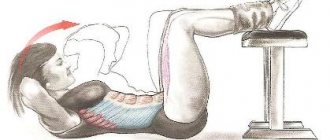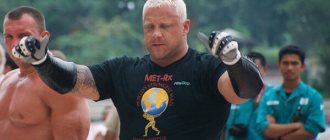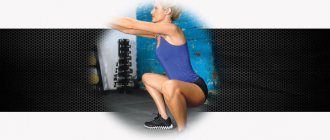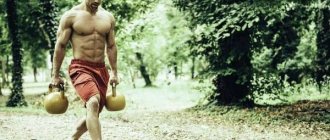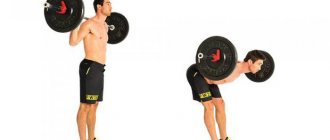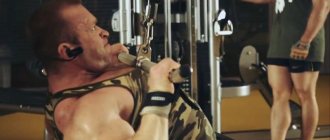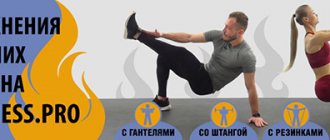Benefits of climbing exercise
During the climbing exercise, many muscle groups are involved. Therefore, with its help you can pump up your whole body, but the greatest burden falls on the abdominal muscles.
The benefits of this exercise are as follows:
- General strengthening of the internal muscles of the trunk, thereby ensuring stabilization of the spine.
- Strengthening the abs, muscles of the arms and legs.
- Correction of posture.
- Strengthening bone tissue.
- Increasing the endurance of the human body and strengthening the immune system.
- Strengthening the cardiovascular system.
In addition, the activity of “climbing” effectively burns fat on the stomach, thighs and buttocks. Therefore, this exercise is recommended for people who want to lose weight and get stronger. Men, women, children and pensioners can do it, since there is nothing complicated in the technique.
How to Add the Climbing Exercise to Your Workout
It all depends on your goals. You can use the climber like:
- An exercise to warm up before strength or cardio training. Insert the exercise into your warm-up after joint warm-up and light cardio. Do 20–25 times.
- Abs exercise. Perform 3-5 sets of 20-25 reps, resting one minute between sets.
- Part of an intensive complex. The Climber is great for high-intensity interval training. The execution time or number of times depends on their format. For example, you can try Tabata—do a rock climb very intensely for 20 seconds, rest for the next 10 seconds, and repeat.
You can do rock climbers every workout, but it's best to alternate them with other abdominal exercises to get a good workout on all your muscles.
Rules for performing the exercise
The classic climber is the simplest, so even beginners can cope with this exercise. But to get perfect abs you need to follow the following rules:
- First of all, you need to monitor your breathing. Don't breathe too hard or too quickly. Breathing should be free and uniform.
- Gradual increase in load. Climbing is a simple and safe abdominal exercise. However, a sharp increase in load and unpreparedness of the body can lead to injuries. Therefore, athletes should pay more attention to the quality of the abdominal exercise rather than the number of repetitions.
- Monitor your body position. The torso should be taut and there should be no arching in the back. If you arch your back, then the entire load will fall on the spine, and not on the abs and arms.
It is important to adhere to these recommendations, since ignoring them will lead to no results.
Climbing technique
1. Take the starting position in the “plank” pose with your arms outstretched. Keep your stomach tucked in and your body aligned so that it forms a straight line from the top of your head to your heels. Hands should be directly under the shoulders. At the same time, squeeze your gluteal muscles, not allowing your pelvis to rise, and lower your shoulders down and do not pull them towards your ears.
2. Bring your right knee towards your chest and, as it approaches, tighten your abs more, not allowing your body to sag and move away from the “plank” position.
3. As you move your right leg, pull your left knee back and down, resting the toe of your foot on the floor. Then push your right leg back and pull your left knee towards your chest, repeating the same actions. Inhale or exhale each time you change
The main thing is not to forget to breathe, because by concentrating on the technique, you can unconsciously hold your breath
4. Continue changing legs, while trying to maintain the set pace, imitating the running position of the lower extremities. Gradually increasing the speed of the exercise, mentally control your body position
Pay attention to maintaining a straight line in the spine and do not lower your head down. The stability of your core is of utmost importance
The order of execution of the classic version
Classic climber:
- In order to do the classic version, you will need to lie on the floor, place your feet shoulder-width apart and straighten your arms. Your palms and toes should rest on the floor. The back should be straight, the buttocks should not be protruded forward. The weight should be evenly distributed throughout the body.
- Next, you need to take a deep breath and tense your abdominal muscles as much as possible. And then you need to pull the knee of your right leg towards your chest; you must not allow it to sway to the sides. At this moment, you need to especially carefully monitor the position of the body, since if the back bends, the abdominal muscle tissue will not be involved.
- Then you need to slowly return to the starting position and exhale. But you can't relax your abs.
The legs must be pulled toward the chest one at a time, and the climber’s steps must be performed evenly. Each person himself determines the number of repetitions of the exercise. In the first few classes, you should not overload the body; it is recommended to gradually increase the complexity of the program.
What muscles work?
The climbing exercise works many muscle groups. Its main advantage is its versatility, as it is suitable for both men and women. It will be an ideal start for obese people, because it combines multi-joint and aerobic characteristics. For the complete anatomy of the exercise, see the table below.
| Muscle group | Movement phase | Role (accent) |
| Triceps | All the time | Static load, with slight dynamic change due to movement characteristics |
Front Delts All the time Static load, with a slight dynamic change due to the peculiarities of movement Pectoral muscles All the time In the classic version, exclusively static load. In the mode with body rotation - static-dynamic load Neck muscles All the time Small static load in work Lower side of the trapezius All the time Static load, with a slight dynamic change due to the peculiarities of movement Rhomboid muscle All the time Static load, with a slight dynamic change due to the peculiarities of the movement Psoas muscle All the time Dynamic load, with a change in emphasis during any movements Core muscles All the time Dynamic load, with a change in emphasis during any movements Lateral abdominal muscles Active phase Dynamic emphasis when turning the body to the sides Oblique abdominal muscles Active phase Dynamic emphasis. Target muscle in the exercise: Biceps femoris In the active phase Helps to pull the legs towards the body. The load is small, but accentuated Gluteal muscles Negative phase Responsible for straightening the legs and returning to the starting position. The load directly depends on the subtype of exercise and the speed of its execution. Calf muscles All the time Static load, with a slight dynamic change due to the peculiarities of movement Carp-shaped groups All the time Static load, with a slight dynamic change due to the peculiarities of the movement Abdominal muscles In the active phase Receive the main load during pulling the legs closer to the body Quadriceps In the negative phase Extension of the leg with acceleration, creates a small load, trains the ligaments, and allows you to perfectly stretch the quadriceps before squatting approaches Cardiac muscle In the active phases of the movement Significant load, which is caused by the multi-joint nature of the exercise and its pace
As you can see from the table, this exercise uses almost all the muscles on the human body. By using special rubber bands, you can significantly increase the emphasis on the abdominal muscles or leg muscles. Unfortunately, due to the inability to evenly distribute the increased load across the entire body, the climber ended up on the list of aerobic exercises.
However, to bring the body into general tone before training, this is the ideal solution.
Varieties of rock climber
In order to pump up your abs faster and diversify your workout, you can use various exercise techniques.
With twisting
You need to take a lying position. After taking a deep breath, you need to bend the knee of one leg and point it to the side towards your shoulder. Then, exhaling, you need to take the starting position. When performing this type of rock climber, the emphasis is on the internal and oblique abdominal muscles.
Hands on the bench
Athletes who exercise at home can use a ball (gymnastic or medicine ball) instead of a bench.
Starting position: lie down, rest your hands on the bench (ball). Your arms should be straightened and placed directly under your shoulders. Having taken IP, you need to pull your knee to your chest (after taking a deep breath). It is important to watch your body; your torso should remain straight. Then you need to return to the IP and repeat everything with the other leg.
Bipedal
It will be difficult for beginners to perform this type of climbing, so it is better for athletes to first master other types of exercise. When performing this type, both legs work at once. Starting position: take a lying position, join your legs, place your hands shoulder-width apart. While exhaling, you need to pull both legs to your chest in a jump, and as you exhale, return them to their original position. The two-legged climber allows you to pump up the muscles of the arms, abs, legs, back, deltas and core.
Each method of execution has its advantages, so you can alternate them or use them all at once.
Technique: how to do it correctly, what to look for, common mistakes
As already mentioned, in order to perform the “Climber” exercise without errors, you need to perform the plank correctly and stand in this position for at least 1-2 minutes.
If a beginner still has problems with this exercise, then first you need to adjust the technique and accustom the body to this load. Only after this can you begin to perform horizontal running.
To perform the “Climber” element, follow the instructions:
- Prop yourself on your hands and toes and fully straighten your upper limbs. Make sure your palms are opposite each other and your legs are at pelvic level.
- Stand so that your back, buttocks, and legs form one line. Tighten the muscles of your abdomen, sides, lower back, and glutes.
- Exhale, begin to bend your left leg at the knee, while simultaneously pulling it as close to your chest as possible.
- The toe can touch the floor or move it in the air.
- When your knee is as close to your chest as possible, hold for 2-3 seconds.
- As you exhale, return your left limb back. Then repeat the exercise for your right leg.
At first, hone your technique, perform the movement slowly to remember the sequence of actions. Over time, the pace of movement can be increased by quickly changing legs, pulling one or the other knee to the chest.
Important! Regardless of the pace of the Climber, the athlete must control the position of the torso and buttocks. This is a very important nuance that affects the load efficiency.
The duration of the workout is from 30 seconds to 1 minute twice or thrice with a break of no more than 1 minute. The main thing is to choose a comfortable speed that will not affect your technique. Over time, the duration of execution and the number of sets can be increased.
To perform the element correctly, you need to take into account common mistakes:
- Deflection of the lower back, lifting of the pelvis upward. When the spine bends, the static load on the abdominal muscles decreases. In addition, it is fraught with back injuries.
- Movement of the upper body. So, beginners try to reduce the load, then the target muscles do not work at full strength.
- Incorrect head position. Some athletes lower or raise their head excessively, but it should form one line with the body. Thus, the load on the cervical segment of the spine is reduced.
- Raising your arms beyond shoulder level. By moving the palms forward, the athlete increases the load on the shoulder joints.
- Rotation of the pelvis while lifting the lower limbs. You need to move your legs in the plane of your torso in order to maximally load your abs.
- Touching your knees to the floor. When lifting, you need to keep your leg in the air to work your abdominal muscles.
To support the lower back and avoid injury, the athlete must shift the load to the muscles of the abdomen and buttocks. Work at a slow pace at first, focusing on lifting your legs and positioning your body. Try to look at the floor while moving so that your neck is positioned correctly. The arms should be fully straightened; when they are slightly bent, the load on the abdominal muscles is reduced.
Be sure to check out:
Gallery image with caption: Learning to restore breathing after physical activity: useful exercises Gallery image with caption: Basic exercises for all muscle groups: a strong and strong body at home Gallery image with caption: Jumping on a trampoline: effectiveness for weight loss Gallery image with caption: How to maintain excellent physical shape after 40 years: choosing exercises
The most common mistakes
Many people, trying to quickly give relief to their abs, forget about the quality of the classes and the rules, which is why the result is not visible. In addition, violation of safety rules and regulations often causes injuries. Mostly beginners make the following mistakes:
- While working, concentrate your body weight on your arms or legs. Under such conditions, it is very difficult to do the exercise, and only the tissues of the arms or legs work, and the tissues of the abdomen are practically not involved.
- Round the lower back. During training, it is important to constantly monitor your back; it should always be straight.
- Incorrect breathing. To quickly develop abdominal definition, you need to breathe, as described above.
Almost all athletes make the following mistakes. To avoid them, you should gradually increase the speed of work, and first practice the technique of the classic “climber”, and then complicate it. You will see that doing the mountain climber exercise is quite simple.
Common mistakes
The desire to do an approach as quickly as possible and a lack of understanding of which muscles work during the “climbing” exercise are the main mistakes of novice athletes. There is no need to rush into the process of mastering the technique. It is better to qualitatively and gradually hone the correctness of the movement, gradually increasing the number of repetitions and speed of movements.
What other errors are there? Let us consider in the table the main technical violations and ways to eliminate them:
| Common Mistakes | How to fix it? |
| In the starting position, the body weight is shifted to the arms or legs. | Distribute your body weight in the starting position between your arms and legs evenly. |
| Shift of the body to one side during leg movements. | Keep your body straight while performing the exercise. The abdomen is tucked up and is in constant tension. |
| Rounded lower back. | Keep your back straight, watch your lower back. It should not sag while climbing. |
| Bent elbows, body weight shifts to the arms, the elbow joint works in overload mode. | The ideal option is straight arms; if this is difficult (weak arm muscles), slightly bent elbows are allowed. |
| Shortness of breath and shallow breathing. | Maintain calm and even breathing throughout the exercise. |
As your endurance increases, gradually progress to performing rock climbers at a fast pace and with as many repetitions as possible. At the same time, fully observing the exercise technique.
General recommendations
To get relief, just playing sports is not enough. Because if a person eats high-calorie foods every day, fat will not be burned. Therefore, to get the ideal figure you need:
- Watch your diet. If you eat unhealthy and fatty foods, then there will be no sense in exercising at all. Since during training the calories received will be burned, but belly fat will remain. Therefore, it is important to change the menu, exclude fatty, flour, sweet and pickled foods from it. Preference should be given to fresh vegetables and steamed foods. It is also important to eat small meals, so that the body processes all the energy and fat does not have time to accumulate.
- Drink enough water. Many people experience digestive problems due to lack of water in the body. Such problems lead to slow metabolism and weight gain.
- Exercise regularly. Some people actively work out for 2-3 days and wait for the result, this does not happen. The result will only appear if a person exercises continuously for 3-4 weeks. You need to train 2-3 times a week without changing your schedule. Since the body gets used to the rhythm of human life, the restructuring may affect it.
A flat tummy with six-packs is the dream of many people. The ab climber exercise will help you make your dream come true. By doing this exercise, a person constantly tenses his abdominal muscles and breathes correctly, and this helps burn fat and show relief. It is not difficult to make a climber correctly, the main thing is to comply with all the requirements.
How to Add the Climbing Exercise to Your Workout
It all depends on your goals. You can use the climber like:
- An exercise to warm up before strength or cardio training. Insert the exercise into your warm-up after joint warm-up and light cardio. Do 20–25 times.
- Abs exercise. Perform 3-5 sets of 20-25 reps, resting one minute between sets.
- Part of an intensive complex. The Climber is great for high-intensity interval training. The execution time or number of times depends on their format. For example, you can try Tabata—do a rock climb very intensely for 20 seconds, rest for the next 10 seconds, and repeat.
You can do rock climbers every workout, but it's best to alternate them with other abdominal exercises to get a good workout on all your muscles.
Exercise “Climber” what muscle groups does it affect?
The quadriceps (quadriceps femoris muscle) must be developed and active, as it functions as a hip extensor. “Climber” is an exercise that effectively works these muscles, which helps prevent many unpleasant consequences and injuries. A well-trained muscular-ligamentous corset will help protect the most vulnerable knee joint.
The gluteal muscles (maximus, medius and minimus) should be well developed as they regulate the balance of the body. The major muscle is one of the powerful muscles that extends and rotates the thigh, fixes and straightens the torso. Medium – moves the pelvis to the side, tilts and straightens the torso. The minor is also involved in straightening the torso and abducting the hip.
The pectoralis minor and serratus anterior muscles are located in the upper chest. Raise and fix the shoulder blade, promote inhalation - raise the ribs.
The deltoid and pectoralis major muscles are involved in shoulder abduction, rotation, and flexion.
The triceps (triceps brachii muscle) abducts the arms back and brings the arms toward the body. Participates in extension of the forearm.
Tips for beginners
- To make it easier for unprepared people to perform the exercises, you can bend your arms slightly at the elbows when performing them.
- It is allowed to rest your feet not on the floor, but on a hill. This is done to relieve stress.
- In the initial stage of execution, it is allowed not to bring the knee completely to the chest.
- It is necessary to monitor the position of the legs; they should not be tilted to the side.
- If the decision is made to do the exercises correctly, then it is necessary to train endurance to complete the exercise, set a faster pace, bring the exercises to the maximum volume and according to all the rules.
These exercises are effective not only for shaping the waist and getting a beautiful stomach, but also for strengthening the muscles of the hips, arms and shoulder girdle .
Add a comment
How to start practicing at home?
The “Climber” exercise is perfect for practicing at home. Requiring no skills or special equipment, it works exactly those muscles that are necessary for a slim, toned figure. It's no secret that problematic pounds appear most often on the buttocks and thighs. It is on these parts of the body that the main load of the exercise is directed. It gives the muscles maximum load, which once again confirms its effectiveness in the fight against fat reserves.
A simple and at the same time quite effective exercise is also attractive because it can be performed either separately or in combination with other exercises. The main thing in home exercises is the right attitude, a gradual increase in load and regularity of training.
You need to choose the appropriate exercise option. Perform it at a slow pace for several days. Class time at the initial stage is no more than 10 minutes. You need to increase your training time and load gradually.
You can build muscle and keep your body in shape by regularly performing the “Climber” exercise. Reviews once again confirm that this simple exercise can reduce back pain, strengthen muscles and restore flexibility to the spine. In addition, daily exercise improves blood circulation and activates metabolism. By performing “Climber” regularly, you will feel a surge of strength and energy.
Benefit
It is difficult to overestimate the benefits of this exercise, since almost all the muscles of the body are involved when performing it. As you know, not only the mobility of the body, but also the course of all physiological processes of the body depends on the proper functioning of the muscles.
“Climber” is an exercise that works well on the core muscles, which is a whole group of deep muscles that lie next to the spine and provide its fixation. The muscles of the body that perform vital functions are involved:
- hip flexor muscles;
- hip extensor muscles in the form of gluteal muscles;
- abdominal muscles: straight and oblique;
- back extensor muscles.
That is, these are the muscles responsible for the position of the body and its orientation. Strengthening your core muscles will help you maintain a healthy spine and beautiful posture. The “Climber” exercise is effective not only for strengthening the back and abs. Its benefit is that it provides firmness and tone to the muscles used in everyday life:
- abductor/adductor scapula - pectoralis minor and serratus anterior muscles;
- leg extensors/flexors – quadriceps femoris;
- foot flexors - gastrocnemius muscle;
- shoulder flexors - deltoid and pectoralis major;
- forearm extensors - triceps.
